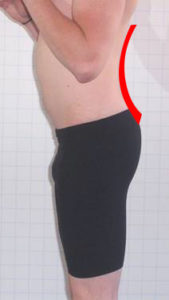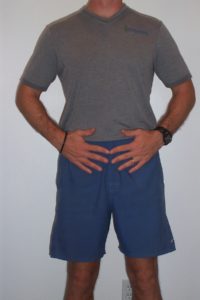How Does the Pelvis Affect the Lower Back
The structures of the lower back (i.e, lumbar spine, sacrum and tailbone) are directly connected to the pelvis by many ligaments and muscles. This relationship helps stabilize this area as well as ensure the whole body moves effectively and efficiently during weight-bearing activities like walking, running, playing sports, etc. This connection also means that if the pelvis is out of alignment then the position and function of the entire lower back region is also affected and can be a major cause of lower back pain.
A Common Pelvis Alignment Problem
One of the most common alignment problems of the pelvis is an anterior pelvic tilt. This is characterized by a downward tilt or drop to the front of the pelvis. This position of the pelvis affects the lower back by causing it to overarch (see Figure 1).

Figure 1: Overarching of the Lower Back Caused by an Anterior Pelvic Tilt
An anterior pelvic tilt and overarching of the lower back can lead to degenerative changes, injury and pain to the structures of the lower back. Therefore, learning how to find the “correct” position for the pelvis is essential to helping you achieve optimal alignment and reduce stress to the structures of this area of the body.
How to Find the “Correct” Pelvis Position
A quick and easy technique to find the “correct” or neutral pelvis position is the “Palms on Pelvis Technique” created by Justin Price from The BioMechanics Method.
- Place the palms of each hand on the bony protuberance on the front of each side of your pelvis (see Figure 2). Your index fingers should touch and be parallel to the ground.
- Look down at your hands and tilt your pelvis posteriorly (i.e., tuck your tailbone under) until you can see both your index and second fingers of both hands. This is a neutral position for the pelvis when standing.

Figure 2: Technique for Finding a “Correct” Pelvis Position
Finding the “correct” position for your pelvis will help you take responsibility for your alignment throughout the day and also reduces stress to the structures of your lumbar spine helping you feel and function better both in the short and long-term. (You can also learn how your pelvis position might be causing your neck and shoulder pain here.)
Fitness, exercise and health professionals interesting in learning a step-by-step process for helping clients overcome muscle and joint pain can choose to enroll in the industry’s highest-rated Corrective Exercise Specialist certification course from The BioMechanics Method. To learn more about this amazing program click on the image below.
